More than any other spot in the country, Kuala Lumpur, or "KL" as it is commonly known, is the focal point of new Malaysia. While the city's past is still present in the evocative British colonial buildings of the Dataran Merdeka and the midnight lamps of the Petaling Street nightmarket, that past is everywhere met with insistent reminders of KL's present and future. The city's bustling streets, its shining, modern office towers, and its cosmopolitan air project an unbounded spirit of progress and symbolize Malaysia's unhesitating leap into the future. To some, this spirit seems to have been gained at the loss of ancient cultural traditions, but in many ways KL marks the continuation rather than the loss of Malaysia's rich past. Like Malacca five hundred years before, KL's commercial centre is a grand meeting place for merchants and travelers from all over the world.
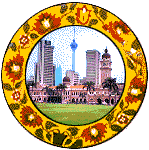 In the same way, the city brings together Malaysia's past and present, its many constituent cultures, and even its remarkable natural treasures, allowing first-time visitors an invaluable opportunity to see Malaysia as a whole before setting off to explore its parts. In the botanical and bird parks of the Lake Gardens one is treated to a first glimpse of the unsurpassed beauty and variety of Malaysia's plants and animals. In the vibrant Central Market, music, crafts, and cultural practices from Kelantan to Sarawak can be explored and experienced. And in the National Museum, the dizzying multiplicity of Malaysia's cultural history comes into focus. As the entry point for most visitors and the meeting point of the country's many attractions, Kuala Lumpur is a grand gateway to a fascinating destination.
In the same way, the city brings together Malaysia's past and present, its many constituent cultures, and even its remarkable natural treasures, allowing first-time visitors an invaluable opportunity to see Malaysia as a whole before setting off to explore its parts. In the botanical and bird parks of the Lake Gardens one is treated to a first glimpse of the unsurpassed beauty and variety of Malaysia's plants and animals. In the vibrant Central Market, music, crafts, and cultural practices from Kelantan to Sarawak can be explored and experienced. And in the National Museum, the dizzying multiplicity of Malaysia's cultural history comes into focus. As the entry point for most visitors and the meeting point of the country's many attractions, Kuala Lumpur is a grand gateway to a fascinating destination.
| Petronas Towers | |
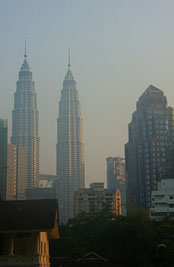 | 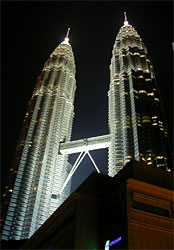 |
| Kuala Lumpur in the morning. | Petronas Towers at night |
With a height of 1,453 feet, one of the world's tallest buildings rise above the skyline of Kuala Lumpur. They are called the Petronas Towers, and, inevitably, they have become the symbols for the astounding growth that has taken place in Malaysia over the last two decades.
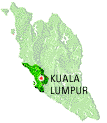 LOCATION
LOCATION
Kuala Lumpur is situated midway along the west coast of Peninsular Malaysia, at the confluence of the Klang and Gombek rivers. It is approximately 35 km from the coast and sits at the centre of the Peninsula's extensive and modern transportation network. Kuala Lumpur is easily the largest city in the nation, possessing a population of over one and a half million people drawn from all of Malaysia's many ethnic group
From Tin Town to Tower City
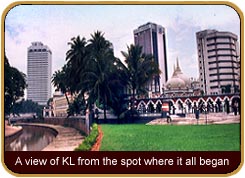 Near the center of Kuala Lumpur, the Klang and Gombak rivers flow quietly together, their confluence barely noticed amid the dwarfing skyline of gleaming new hotels and office buildings. A few feet from the place where the rivers meet, the Jamek Mosque rests in the middle of it all like a piece of beautiful antique furniture, curiously left behind in a living room renovated for the space age. Walk to the rear of the mosque, and you will come to a small grassy field; walk to the southernmost edge of the field, and you can stand at the exact point where the rivers join. It is a strange place to stand. Overshadowed by the crowded skyline, the spot feels improbably humble and empty. It seems impossible that the entire city sprung from this one spot.
Near the center of Kuala Lumpur, the Klang and Gombak rivers flow quietly together, their confluence barely noticed amid the dwarfing skyline of gleaming new hotels and office buildings. A few feet from the place where the rivers meet, the Jamek Mosque rests in the middle of it all like a piece of beautiful antique furniture, curiously left behind in a living room renovated for the space age. Walk to the rear of the mosque, and you will come to a small grassy field; walk to the southernmost edge of the field, and you can stand at the exact point where the rivers join. It is a strange place to stand. Overshadowed by the crowded skyline, the spot feels improbably humble and empty. It seems impossible that the entire city sprung from this one spot.
Yet in 1857, this is where it all began. A group of 87 miners, all of them Chinese, poled their way up the Klang in search of tin. At that time, tin was in huge demand, especially by America and the British Empire, which needed the durable, lightweight metal to help fuel their industrial revolutions. In Ampang, few miles to the east, there were huge reserves of it, and this spot was the highest point where the prospectors could land their supplies. They named it "muddy confluence," built a ramshackle, thatched-roof village, and within a month all but 17 of them had died of malaria. It was a devastating beginning to what would become one of Asia's richest cities. More tin prospectors, however, soon followed, and within a few years the village thrived. Like all mining boom-towns, it was raucous place, populated almost exclusively by men.
|
Near KL are the world's largest reserves of tin. The lightweight metal, which is used in the alloys bronze and pewter, was the foundation of KL's early economy. | |
| They spent their days in grueling labor, crouching over tin pans or digging the earth, returning to the town at dusk to console their loneliness in bars, gambling halls, and brothels. | ...the Chinese miners organized themselves into clans and warring factions called "secret societies." |
Few got rich, but throughout the peninsula the mania for tin inspired fierce rivalries and claim disputes. As they did in the gold fields of California, the Chinese miners organized themselves into clans and warring factions called "secret societies." Without a centralized Chinese authority keeping peace, order in the mining areas was nearly impossible. Whole clans could be swept up in fights that started over little more than a drunken dispute between two men. In 1868, needing a solution to the chaos, the headmen of the local clans elected a man named Yap ah Loy as "Kapitan China," or leader of the Chinese community. With the support of the local sultan, he built prisons and quelched revolts, quickly establishing an infamous reign over the entire Kuala Lumpur mining area. If KL has a "founding father," it is Loy.
Loy had barely established control, however, when the Malay Civil War broke out a few years later. Local sultans were fighting for the throne of Perak, and KL, swept up in the conflict, burned to the ground. The merchants of the Straits Settlements, concerned that the war would ruin their prosperity, asked Britain to intervene. Britain was initially reluctant to get involved with internal politics, but rumors that the merchants would turn to Germany instead sparked a fear in London that Britain could lose its tin interests in Malaya. London sent in a new territorial governor, Andrew Clarke, to apprise the situation. Clarke gathered the feuding princes aboard his ship off the island of Pangkor, and convinced them to sign a document known as the Pangkor Agreement. The Agreement ended the war, established a new Sultan of Perak, and -- most significantly -- called for the presence of a British Resident "who must be asked and acted upon on all questions other than those touching Malay religion and custom." This was the beginning of a dramatically increased British involvement in Malaya, one that would eventually place Kuala Lumpur at center of history.
The British residential system quickly spread. Frank Swettenham, the Resident of Selangor, chose Kuala Lumpur as his administrative center and oversaw the rebirth of the city, ordering the construction of new buildings using brick. In 1896, Swettenham convinced the Sultans of four states to unite under the umbrella of the Federated Malay States (FMS), and Kuala Lumpur was chosen as the capital. The city became a classic center of British colonialism. Sharply uniformed officers and bureaucrats administered the FMS from beneath the distinctive copper domes of the Sultan Abdul Samad Building. In the off-hours, they played cricket on the field of the Padang and sought liquid comfort in the Selangor Club, where only whites were allowed. Unsurprisingly, the club became a symbol of British imperialism and oppression and fueled the ever-growing dreams of independence. At midnight on August 30, 1957, amidst a crowd of tens of thousands, British soldiers finally lowered the Union Jack for the last time in front of the Selangor Club. Interestingly, the old British watering hole would become the meeting place of the new Malaysian elite.

